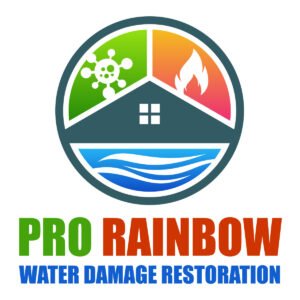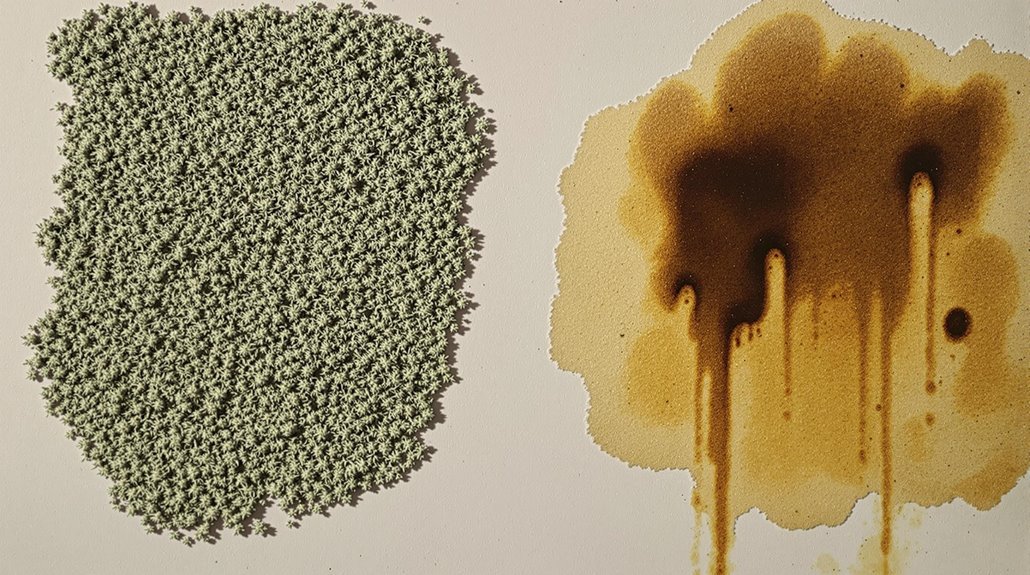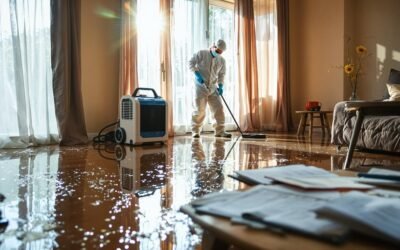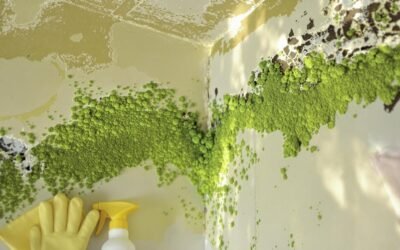To tell the difference between mold and water damage, examine the visual signs, odors, and growth patterns. Mold usually presents as discolored patches—black, green, or white—with a musty smell, thriving in damp, dark areas like basements or behind appliances. Water damage typically appears as yellow or brown stains, often accompanied by soft or warped textures. Odors are damp and stale, fading once the moisture source is resolved. Identifying where these issues occur helps distinguish them. Understanding these characteristics is essential for effective remediation, and there's more to investigate about prevention and health implications ahead.
Key Takeaways
- Mold typically appears as distinct color variations, while water damage shows as yellow or brown stains on surfaces.
- Mold emits a persistent musty odor, whereas water damage produces a damp, stale smell that fades when moisture is resolved.
- Mold thrives in dark, damp areas with limited airflow, while water damage is often found near pipes, windows, and roofs.
- Prolonged exposure to mold can cause severe health issues, while water damage primarily leads to mold growth, contributing to health risks.
- Regular inspections and proper ventilation can prevent both mold and water damage, emphasizing the importance of maintaining dry environments.
Visual Signs of Mold
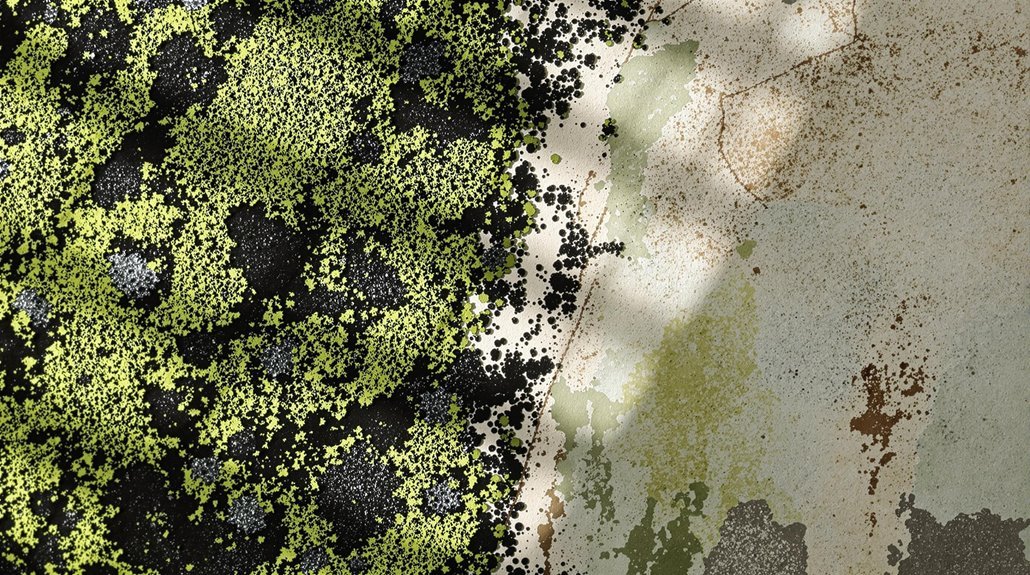
Mold often presents itself in distinct visual signs that can help you identify its presence in your home. You'll notice various mold types manifesting through color variations, which can range from black to green, white, and even orange. Each color often indicates a different mold type and may suggest varying levels of health risk. For example, black mold, typically appearing dark green or black, is notorious for its potential toxicity. On the other hand, green mold, often found in damp areas, may not pose immediate threats but still requires attention. Spotting these color variations early allows you to address potential mold issues before they escalate, ensuring a healthier living environment. Keep an eye out for these visual cues to safeguard your home. Additionally, understanding the mold remediation process can aid in effectively managing any mold issues you may encounter.
Visual Signs of Water Damage
Identifying water damage in your home is just as important as recognizing the signs of mold. Start by checking for water stains on ceilings, walls, and floors. These stains typically appear as yellow or brown patches, indicating prolonged moisture exposure. Next, examine the surface textures; water-damaged areas may feel soft, swollen, or warped. You might additionally notice peeling paint or wallpaper, which can signal underlying moisture issues. Pay attention to any discoloration or bubbling in surfaces, as these can suggest hidden water infiltration. Finally, inspect areas around windows, pipes, and roofs, where leaks are common. By actively looking for these visual signs, you can address potential water damage before it escalates into a more serious problem. Additionally, addressing appliance leaks early can significantly reduce the risk of extensive water damage.
Odor Differences
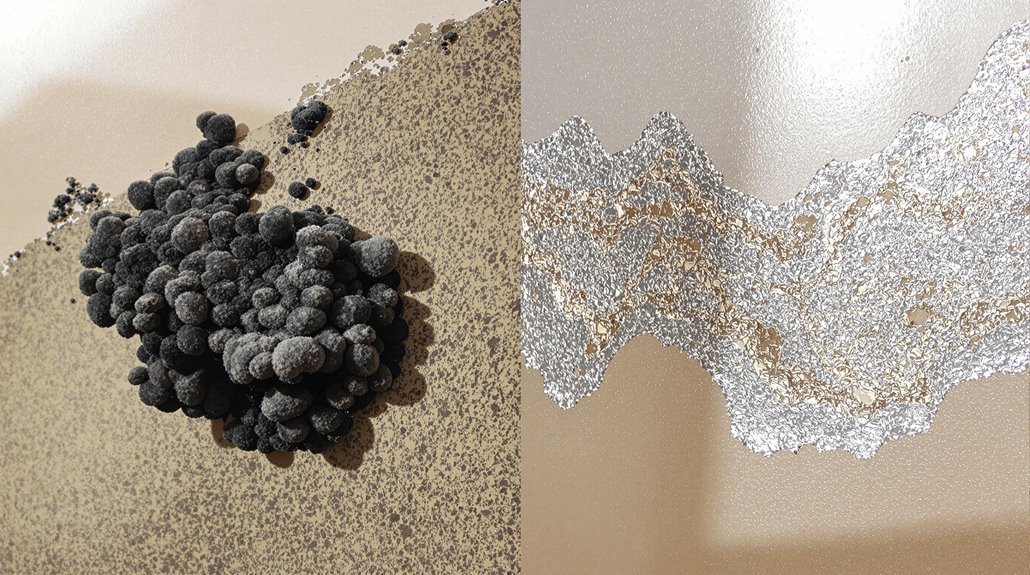
When evaluating odors, you'll notice that mold and water damage each have distinctive smell profiles. Mold often emits a musty, earthy scent that lingers, while water damage might produce a damp, stale odor that can vary in strength. Understanding these differences in duration and intensity can help you pinpoint the underlying issue more effectively.
Distinctive Smell Profiles
How can you tell if you're dealing with mold or just water damage by scent alone? Distinctive smells can provide clues. Mold types often emit a musty, earthy odor, indicating fungal growth. This smell typically arises from stagnant water sources, where mold thrives. Conversely, water damage tends to have a damp, wet cardboard or fabric smell that lacks the complexity associated with mold.
| Odor Profile | Mold Types | Water Sources |
|---|---|---|
| Musty | Aspergillus, Penicillium | Flooded areas |
| Earthy | Cladosporium | Leaking pipes |
| Damp | Stachybotrys | Roof leaks |
| Sharp | Alternaria | Humid conditions |
| Foul | Botrytis | Standing water |
Recognizing these differences can help you assess the situation effectively.
Duration of Odor
While distinctive smells can indicate whether you're facing mold or water damage, the duration of these odors can provide further insight into the underlying issue. Mold typically produces persistent odors that linger over time, especially in damp or humid conditions. If you notice a musty smell that doesn't dissipate, it's likely linked to ongoing mold growth. Conversely, water damage odors often fade more quickly, especially if the source of moisture is addressed. The difference in odor duration can be essential; prolonged scent persistence points to mold, while transient smells may indicate temporary water damage. Monitoring these odors can help you identify the problem more accurately and take appropriate action.
Strength of Scent
Although both mold and water damage can produce unpleasant odors, the strength of the scent often varies considerably between the two. Mold typically emits a musty, earthy aroma that tends to have high scent intensity. This odor can linger persistently, making it easily identifiable over time. Conversely, water damage usually results in a more subtle, damp smell that may not be as overpowering. Nevertheless, if water damage leads to mold growth, you might notice an increase in scent intensity as the mold develops. Understanding these differences in odor persistence can help you determine the source of the problem, allowing you to take appropriate action for remediation.
Location and Growth Patterns
When evaluating damage in your home, understanding the location and growth patterns of mold and water damage can reveal critical differences. Water damage typically occurs in areas with high moisture exposure, such as around pipes, windows, or roofs. It's often visible as stains or discoloration on walls and ceilings. Conversely, mold thrives in specific location types, particularly in damp, dark areas like basements, bathrooms, or behind appliances. The growth conditions for mold include consistent moisture, organic material, and limited airflow. If you notice mold, look for its characteristic spots or patches. Identifying these patterns helps you distinguish between water damage, which may require immediate repairs, and mold, which often indicates a prolonged moisture problem.
Health Implications
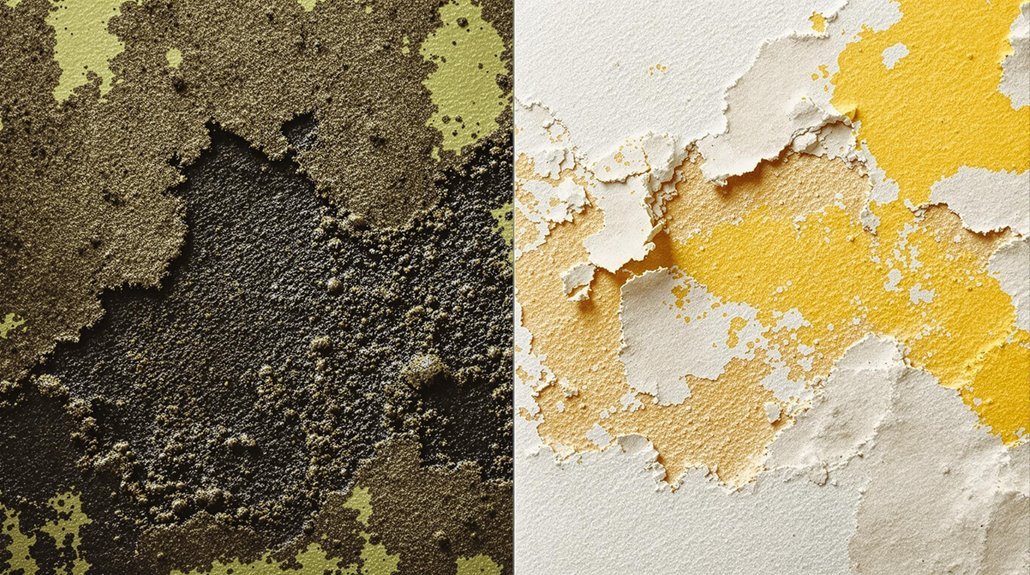
Understanding the health implications of mold and water damage is vital for maintaining a safe living environment. Mold spores can trigger various health risks, particularly in sensitive individuals. You might experience allergic reactions, which can manifest as sneezing, coughing, skin rashes, or even asthma attacks. Prolonged exposure to mold can lead to more severe respiratory issues. Water damage, even without visible mold, can likewise contribute to health problems by promoting an environment favorable to mold growth. It's important to address any leaks or moisture promptly to mitigate these risks. By understanding the potential health implications, you can take proactive measures to guarantee your home remains a healthy space, protecting yourself and your loved ones from adverse health effects.
Detection Methods
To effectively identify the presence of mold or water damage in your home, you'll want to employ a combination of visual inspections and specialized tools. Start by examining areas prone to moisture, like basements and bathrooms, looking for discoloration or musty odors. Use detection tools, such as moisture meters, to measure humidity levels in walls and materials. These tools can help pinpoint hidden moisture that might indicate water damage. In addition, infrared cameras can reveal temperature differences, highlighting potential water leaks behind surfaces. Regularly monitoring humidity levels in your home can also prevent conditions favorable for mold growth. By combining these methods, you can accurately assess whether you're dealing with mold or water damage, allowing for knowledgeable choices moving forward.
Remediation Approaches
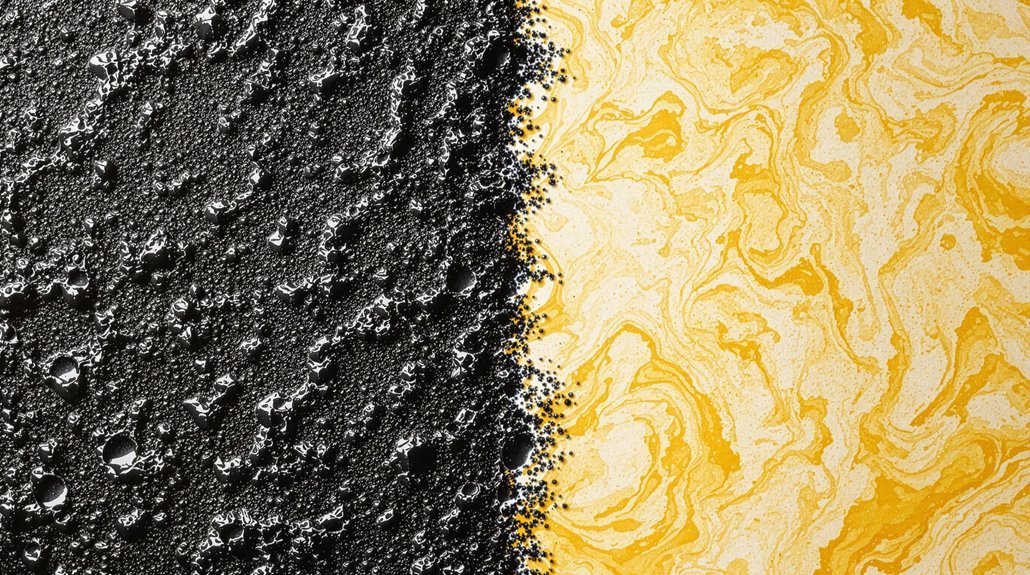
While confronting mold or water damage, taking prompt and effective remediation steps is essential to prevent further issues. First, consider a professional assessment to identify the extent of the damage. Depending on the findings, various remediation techniques can be applied. Here's a quick overview:
| Type of Damage | Remediation Technique | Considerations |
|---|---|---|
| Mold | Removal of affected materials | Guarantee proper PPE usage |
| Water Damage | Dehumidification and drying | Monitor humidity levels |
| Structural Damage | Repair or replace materials | Inspect for hidden damage |
| Prevention | Improve ventilation | Regular inspections recommended |
Conclusion
In conclusion, distinguishing between mold and water damage is essential for maintaining a healthy home. Mold often thrives in dark, damp areas, while water damage leaves visible stains and deterioration. The musty odors of mold can be overwhelming, like a skunk at a picnic, signaling an urgent need for action. By recognizing the signs and understanding the implications, you can take the necessary steps to protect your space and well-being effectively. Don't underestimate the importance of prompt detection and remediation.
